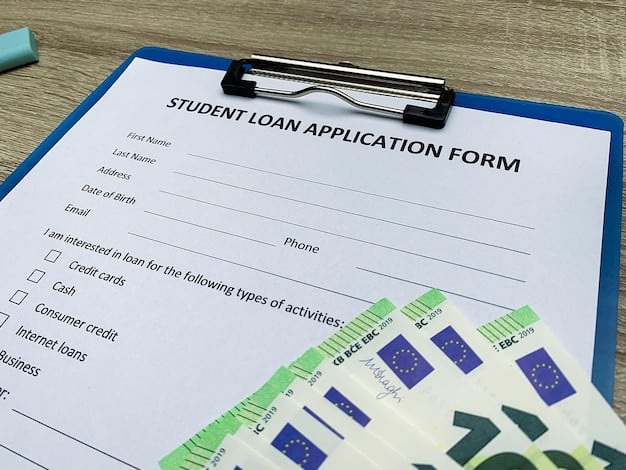Smart Borrowing: Federal vs. Private Student Loans in the US (2025 Update)

In 2025, navigating student loans requires understanding the key differences between federal and private options, including eligibility, interest rates, repayment terms, and borrower protections, to make informed decisions about financing higher education in the US.
Navigating the complexities of student loans is crucial for funding higher education in the US. The decision between federal and private student loans can significantly impact your financial future. This article breaks down the essentials of smart borrowing: comparing federal vs. private student loans in the US (2025 update), helping you make informed choices.
Understanding Federal Student Loans
Federal student loans are funded by the federal government and come with specific terms and conditions set by law. These loans often offer more borrower protections and flexible repayment options compared to private loans, making them a popular choice for many students.
Let’s delve into the types and advantages of federal student loans.
Types of Federal Student Loans
There are several types of federal student loans available. Each caters to different needs and eligibility criteria. Here’s a quick overview:
- Direct Subsidized Loans: Available to undergraduate students with demonstrated financial need. The government pays the interest while the student is in school, during the grace period, and during deferment.
- Direct Unsubsidized Loans: Available to undergraduate, graduate, and professional students. Interest accrues from the time the loan is disbursed, even while the student is in school.
- Direct PLUS Loans: Available to graduate or professional students and parents of dependent undergraduate students. These loans have higher interest rates and require a credit check.
Advantages of Federal Student Loans
Federal student loans offer several benefits that can be advantageous for borrowers:
- Income-Driven Repayment Plans: These plans adjust monthly payments based on income and family size, making repayment more manageable.
- Loan Forgiveness Programs: Programs like Public Service Loan Forgiveness (PSLF) offer forgiveness after a certain number of qualifying payments for those working in public service.
- Deferment and Forbearance Options: These options allow borrowers to temporarily postpone or reduce payments during periods of financial hardship.
Federal student loans provide a safety net with various repayment plans and forgiveness options. Knowing these benefits can aid in making informed borrowing decisions.
Exploring Private Student Loans
Private student loans are offered by private lenders such as banks, credit unions, and other financial institutions. Unlike federal loans, they are not backed by the government, and their terms and conditions can vary widely. These loans are often used to fill funding gaps after exhausting federal loan options.
Let’s explore when and why one might opt for private loans.
When to Consider Private Student Loans
Private student loans may be a viable option in specific circumstances:
- Federal Loans Are Insufficient: When federal loans don’t cover the total cost of education, private loans can help bridge the gap.
- For Non-Traditional Students: Students attending part-time, non-degree programs, or those not meeting federal eligibility requirements may find private loans more accessible.
- Creditworthy Borrowers: Individuals with strong credit scores or willing to have a cosigner may secure better interest rates with private loans.
Understanding the Terms and Conditions
It’s crucial to understand that private student loans operate differently from federal loans:
Interest rates on private loans can be fixed or variable. Fixed rates remain constant over the life of the loan, while variable rates fluctuate with market conditions. Repayment terms also vary, with some lenders offering shorter or longer repayment periods.
Borrower protections are generally fewer with private loans. They may not offer income-driven repayment plans or loan forgiveness programs, so it’s essential to read the fine print.

Private student loans should be approached with caution. Carefully compare terms, conditions, and borrower protections before making a decision.
Interest Rates and Fees: Federal vs. Private
Interest rates and fees significantly impact the total cost of borrowing. Understanding the differences between federal and private loans can help you choose the most cost-effective option.
Let’s compare the interest rates and fees associated with each type of loan.
Federal Loan Interest Rates
Federal student loan interest rates are typically fixed and determined by Congress. These rates are set annually and apply to new loans disbursed each academic year. As of the 2024-2025 academic year, interest rates for Direct Subsidized and Unsubsidized Loans for undergraduates are around 5.05%, while Direct PLUS Loans for parents and graduate students hover around 7.60%.
Federal loans also come with origination fees, which are a percentage of the loan amount. These fees are deducted from the loan disbursement, so borrowers receive slightly less than the amount borrowed. For instance, origination fees for Direct Loans are typically around 1.057%, while Direct PLUS Loans have fees of about 4.228%.
Private Loan Interest Rates
Interest rates on private student loans are determined by the lender and are based on the borrower’s creditworthiness and prevailing market conditions. These rates can be fixed or variable. Borrowers with excellent credit scores may qualify for lower interest rates, often comparable to or even lower than federal loan rates.
Variable interest rates fluctuate with the prime rate or another benchmark, which could lead to unpredictable monthly payments. Private lenders may also charge fees such as origination fees, late payment fees, or prepayment penalties. It’s crucial to compare these fees across different lenders to find the best overall deal.
When evaluating interest rates and fees, consider not just the initial rate but also the potential for changes over the loan term. Federal loans provide the stability of fixed rates, while private loans offer the potential for lower rates but carry the risk of fluctuations.
Repayment Options and Flexibility
Repayment flexibility is a critical factor when choosing between federal and private student loans. Federal loans are known for their various repayment plans, while private loans typically offer fewer options.
Let’s dive into the details of repayment options for each.
Federal Loan Repayment Plans
Federal student loans offer a variety of income-driven repayment (IDR) plans designed to make monthly payments more manageable. These plans include:
- Income-Based Repayment (IBR): Sets monthly payments based on income and family size, with loan forgiveness after 20 or 25 years.
- Pay As You Earn (PAYE): Caps monthly payments at 10% of discretionary income, with loan forgiveness after 20 years.
- Revised Pay As You Earn (REPAYE): Similar to PAYE but includes some graduate students and parents, with loan forgiveness after 20 or 25 years.
For borrowers not eligible for IDR plans, there are other options such as the Standard, Graduated, and Extended Repayment Plans. The Standard Plan offers fixed payments over 10 years, while the Graduated Plan starts with lower payments that increase over time. The Extended Plan allows borrowers to stretch out payments over 25 years.
Private Loan Repayment Options
Private student loans typically offer fewer repayment options compared to federal loans. Many lenders offer standard repayment plans with fixed monthly payments over a set period, usually 10 to 20 years. Some lenders may provide options such as:
- Graduated Repayment: Payments start low and increase over time.
- Interest-Only Payments: Borrowers pay only the interest for a limited period.
- Forbearance: Allows borrowers to temporarily postpone payments during financial hardship.
However, these options are not as comprehensive as those available with federal loans, and terms can vary widely between lenders. It’s essential to carefully review the repayment options and flexibility offered by each private lender before committing to a loan.

When assessing repayment options, consider your current and future financial situation. Federal loans provide a safety net with IDR plans, while private loans may offer less flexibility but potentially lower initial payments.
Borrower Protections and Relief Programs
Borrower protections and relief programs are crucial safety nets for student loan borrowers facing financial difficulties. Federal student loans generally offer more robust protections compared to private loans.
Let’s explore the key differences in borrower protections between federal and private loans.
Federal Loan Borrower Protections
Federal student loans come with several borrower protections designed to help borrowers manage their debt and avoid default. Key protections include:
- Deferment: Allows borrowers to temporarily postpone payments due to economic hardship, unemployment, or other qualifying circumstances.
- Forbearance: Permits borrowers to temporarily reduce or postpone payments due to financial difficulties.
- Discharge: Cancels the loan under specific circumstances, such as school closure, disability, or death.
Furthermore, federal loans offer access to loan forgiveness programs like Public Service Loan Forgiveness (PSLF), which forgives the remaining balance after 10 years of qualifying payments for those working in public service. The Teacher Loan Forgiveness program provides forgiveness for teachers working in low-income schools.
Private Loan Borrower Protections
Private student loans typically offer fewer borrower protections compared to federal loans. While some private lenders may provide forbearance options during financial hardship, these are generally less generous and have stricter eligibility requirements.
Private loans may not offer deferment or discharge options comparable to federal loans. Borrowers may have limited recourse if their school closes or if they become disabled. Some private lenders may offer co-signer release options after a certain number of on-time payments, but this varies by lender.
When evaluating borrower protections, consider the potential risks you may face during your repayment period. Federal loans provide a more comprehensive safety net, while private loans may offer fewer options and less flexibility.
Making the Smart Borrowing Choice in 2025
Choosing between federal and private student loans requires careful consideration of your financial situation, long-term goals, and risk tolerance. As of 2025, making an informed decision is more crucial than ever due to evolving economic conditions and educational costs.
Let’s summarize the key factors to consider when making your choice.
Assess Your Financial Situation
Start by evaluating your current and future financial situation. Consider your income, expenses, and potential career earnings. Determine how much you can realistically afford to repay each month. Estimate the total cost of your education, including tuition, fees, and living expenses.
Compare Loan Options
Research and compare the terms and conditions of both federal and private student loans. Pay attention to interest rates, fees, repayment options, and borrower protections. Use online tools and calculators to estimate your monthly payments and total repayment costs under various scenarios.
Prioritize Federal Loans
In most cases, federal student loans should be your first choice due to their flexible repayment options, borrower protections, and potential for loan forgiveness. Exhaust all federal loan options before considering private loans. If you still need additional funding, use private loans to supplement federal aid.
Making the smart borrowing choice involves weighing the pros and cons of each type of loan and selecting the option that best aligns with your financial needs and goals. Consider seeking advice from a financial advisor to help you navigate the complexities of student loans.
| Key Aspect | Brief Description |
|---|---|
| 💰 Interest Rates | Federal: Fixed rates set by Congress. Private: Variable rates based on creditworthiness. |
| 🛡️ Borrower Protections | Federal loans offer deferment, forbearance, and loan forgiveness programs. Private loans have fewer options. |
| 📅 Repayment Plans | Federal loans include income-driven repayment plans. Private loans offer fewer flexible repayment options. |
| 📝 Eligibility | Federal: Based on financial need and enrollment status. Private: Based on creditworthiness. |
Frequently Asked Questions
▼
Subsidized loans are for undergraduates with financial need; the government pays the interest while you’re in school. Unsubsidized loans are available to all students, but interest accrues from disbursement.
▼
IDR plans set your monthly payment based on your income and family size. After a set number of years, the remaining balance is forgiven, though you may owe taxes on the forgiven amount.
▼
PSLF forgives the remaining balance on your federal loans after you’ve made 120 qualifying payments while working full-time for a qualifying public service employer.
▼
Yes, but refinancing federal loans into a private loan means you’ll lose federal protections like IDR plans and forgiveness options. Only do this if you’re confident in your ability to repay.
▼
Contact your loan servicer immediately. For federal loans, explore IDR plans, deferment, or forbearance. For private loans, discuss options with your lender, but be aware they may be limited.
Conclusion
Smart borrowing involves making informed decisions about financing your education. By understanding the differences between federal and private student loans, you can choose the options that best suit your financial situation and long-term goals. Prioritize federal loans for their protections and flexibility, and consider private loans as a supplement if necessary.





